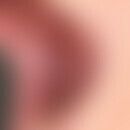Synonym(s)
DefinitionThis section has been translated automatically.
Pyemotes mites are known to be about 20 different species) belong to a genus of mites (Acari) from the order of Actinedida, formerly Trombidiformes. Pyemotes are about 0.02 cm long (but the pregnant females can swell up to 0.2 cm in size in spherical form = Physogastrie).
Female mites suck with stiletto-like chelicers on larvae of hymenopterans, butterflies and beetles.
Some insect parasitic species can cause severe dermatitic (mostly urticarial) reactions in humans. They only infest humans when the primary host is not available to them. In these cases, humans are therefore the false host (see also trombidiosis, see also cereal scabies).
Occurrence/EpidemiologyThis section has been translated automatically.
Several Pyemotes species have been identified as the cause of these epizoonoses:
- Pyemotes tritici (grain itch mite; straw itch mite; puffer mites): Dermatitic reactions caused by Pyemotes tritici have been observed in persons working with straw, hay or grain supplies (grain dross). The natural hosts of Pyemotes tritici are larvae of beetle or butterfly species. Pyemotes tritici infests people who handle the infested objects. Particularly at risk are workers in granaries, people handling grass seed or hay, or florists arranging dried flowers.
- Pyemotes ventricosus (grain beetle mite): This parasitosis occurs in persons who have been in contact with old wood or furniture. The actual host of the mite species are "woodworms" (the larvae of the common nail beetle, Anobium punctatum).
- Pyemotes herfsi (moth mite): Pyemotes herfsi parasitizes a number of insects, including the larvae of the clothes moth (Tineidae), bees and gall midges of the genus Contarinia (which cause plant gall on oak trees). In North America, smaller endemics occurred in humans due to Pyemotes herfsi infestation. The legs were mainly affected, caused by mites that fell from the trees.
You might also be interested in
DiagnosisThis section has been translated automatically.
Clinical evaluation. The diagnosis can be made based on the patient's medical history (e.g. place of residence, place of work and leisure environment) and physical examination. The mites themselves are rarely found, as they fall off after the bite.
TherapyThis section has been translated automatically.
Treatment is symptomatic: topical corticosteroids and oral antihistamines.
Further research should be done on the source of mite infestation to prevent further exposure.
LiteratureThis section has been translated automatically.
- Cross E A (1965). The generic relationships of the family Pyemotidae (Acarina: Trombidiformes). The University of Kansas Science Bulletin 45: 29-275.
- Herfs A (1926). Ecological studies on Pediculoides ventricosus (Newp.) Berlese. Zoologica Original papers from the whole field of zoology74: 3-68.
Outgoing links (1)
Grain dross;Disclaimer
Please ask your physician for a reliable diagnosis. This website is only meant as a reference.




